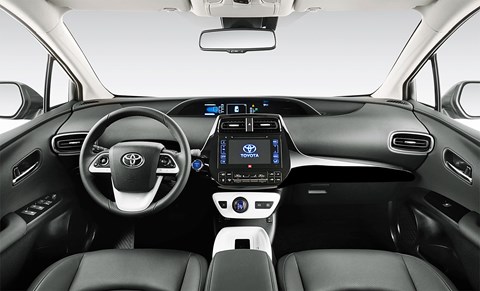► We drive the all-new 2016 Toyota Prius
► Fourth-generation electric hybrid is here
► A definite improvement over the Mk3, but hard to love
Contrary to its clean-air credits and the consequential green image, the Toyota Prius has never been an overly eco-friendly car, with a CO2 footprint no slimmer than that of a Golf diesel.
The new Prius, due on sale early 2016, is being heralded as a much more frugal piece of kit. Acceleration and top speed are unchanged, but fuel economy improves from 72.4mpg and 89g/km CO2 to 94.2mpg and 70g/km CO2. Battery, motor and control unit are only responsible for 10% of the gains: more substantial contributors include the improved engine, low-friction transaxle and the new vehicle architecture. The 1.8-litre engine up front is to all intents and purposes the same old non-turbo DOHC unit. It relies heavily on the instant torque generated by the 60kW e-motor to compensate its own lack of grunt. Together, the two manage 120bhp, and improvements made have been made to combustion efficiency, friction reduction and heat management.
A brief drive in a Mk3 Prius is a timely reminder of just what a wholly unexciting car it is. The drivetrain feels rough, the suspension brittle and handling is an alien term. The space age interior is a depressing plastic desert with all the charm of a dusty old desktop PC. So hope is riding low as I climb into the new one. It’s still some way short of being an ergonomic masterpiece. The main Atari-style digital instruments glow dimly, the dash itself is like a freezeframe from a black polyurethane tsunami, and the main controls – gear selector, mode switch, EV button – sit in a white appendix below the dominating centre stack.
Taking off on electric power alone undoubtedly makes you feel good but the e-effect doesn’t last long, and the car’s pace means there’s plenty of time for making mental notes… The seats, which used to be filled with an indifferent foam and cement mix, are now better shaped, a little cushier and more generously adjustable, and it’s impossible not to notice the dramatically improved refinement. Wind, road, engine and air conditioning noise are all well suppressed now, and the swooshy cabin architecture looks and feels far better.

The fourth-generation Prius is the first model based on TNGA, Toyota’s new-generation architecture. Although wheelbase (2700mm) and weight (1445kg) are unchanged, a lower hip point has brought down the centre of gravity. To the same end the battery pack is now mounted below the rear bench rather than below the cargo deck. As a welcome side effect, luggage capacity is up by 56 litres to 502 litres. The body of the TNGA-based Prius is said to be 60% stiffer, with profound effects on handling precision and crashworthiness. Also new are the compact double-wishbone rear suspension, the revised front axle and the carefully honed aerodynamics. Get moving and there is a newfound agility to Prius; less body roll, reduced yaw, better steering response, enhanced cornering stability and clearer communication between car and driver. This newly discovered smoothness is epitomised by the recalibrated suspension and its cossetting ride: not a word you’d ever use to describe its predecessor. The hybrid powertrain is slicker too. Throttle action is more prompt now, and although this is by no means a high-performance hybrid you appreciate the more urgent e-motor and its smoother interaction with the petrol engine and the CVT transmission.
While the march towards a lithium-ion battery future appears inexorable, there is no indication that Toyota will abandon hybrids in the near future. It is quite obviously a financially rewarding approach for the Japanese firm: in 2014, every second hybrid car sold in Europe was a cableless Toyota.
The specs: Toyota Prius
Price: £23,295
Engine: 1797cc 16v hybrid 4-cyl, 97bhp @ 5200rpm, 105lb ft @ 3600rpm, plus 71bhp e-motor
Transmission: Planetary, front-wheel drive
Performance: 10.6sec 0-62mph, 112mph, 94.2mpg, 70g/km CO2
Weight: 1445kg
On sale: Now
Love – Looks, slick CVT, improved ride, smart packaging
Hate – Looks, ergonomics, ho-hum overall refinement, paucity of driver involvement
Verdict – One giant leap for Prius… but it’s still dull
Rating – ***